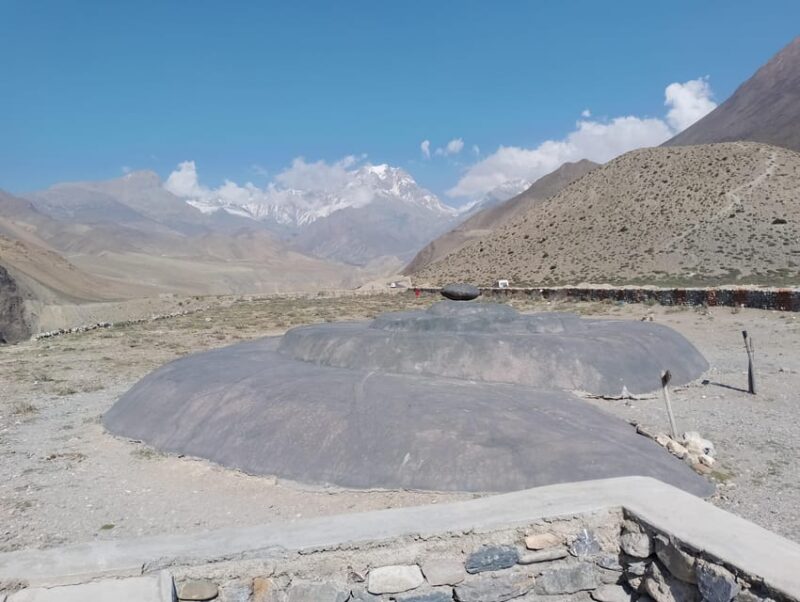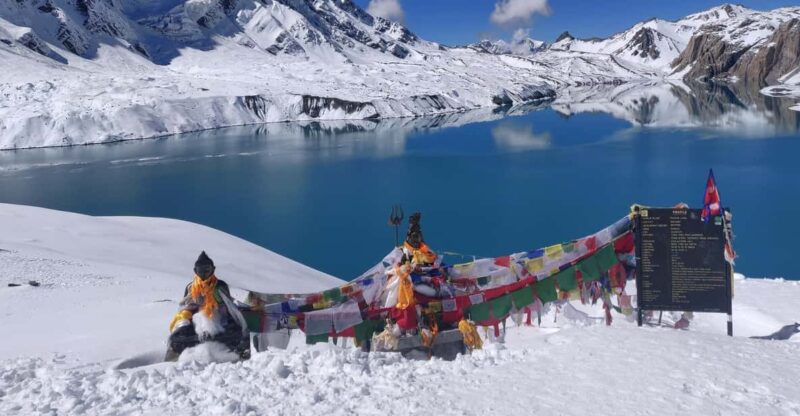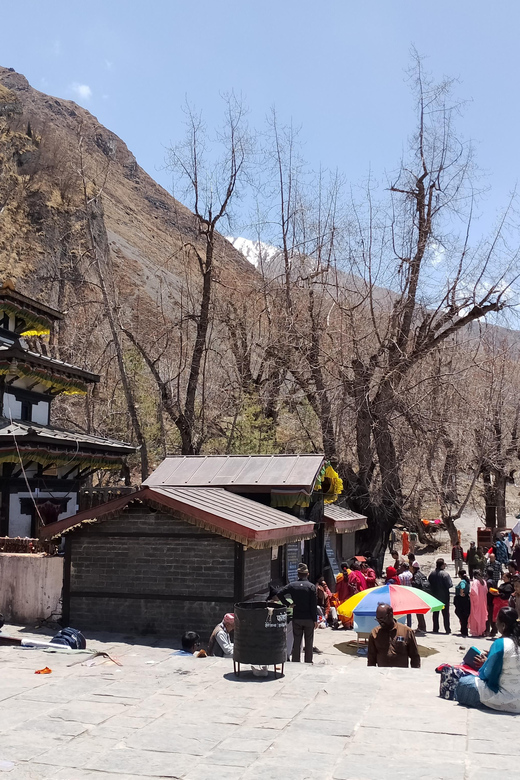The 15-Day Annapurna Circuit with Poon Hill Trek starts in Kathmandu, where trekkers can expect a well-rounded mix of stunning natural beauty and rich cultural encounters. They’ll experience everything from lush valleys to towering peaks, all while connecting with local communities like the Gurung and Thakali. It’s not just about the views; it’s also about understanding the traditions and lifestyles of those who call these mountains home. But before setting off on this adventure, there are some essential tips and insights that can make all the difference in how one experiences this incredible journey.
This experience made our list of the 25 Best Treks And Hiking Tours In Pisang.
Key Points

- The Annapurna Circuit Trek spans 15 days, starting with a drive from Kathmandu to Syange and culminating in Poon Hill views.
- Key highlights include crossing Thorong La Pass at 5,416 meters and experiencing panoramic sunrise views of the Annapurna and Dhaulagiri ranges.
- Trekkers interact with local communities like Gurung, Thakali, and Manangi, enriching their cultural experience throughout the journey.
- Essential inclusions encompass experienced guides, accommodation in guesthouses, and management of necessary permits for a seamless trekking experience.
- Ideal trekking seasons are from March to May and September to December, offering the best weather conditions and stunning natural scenery.
Trek Overview and Highlights

The Annapurna Circuit Trek offers adventurers an unforgettable journey through stunning landscapes, vibrant cultures, and breathtaking mountain vistas that make it one of Nepal’s most sought-after trekking routes.
Spanning 15 days, trekkers will experience diverse terrains, from lush subtropical forests to stark high-altitude deserts. One of the trek’s highlights is crossing Thorong La Pass, one of the highest trekking passes in the world at 5,416 meters.
Early risers can savor panoramic sunrise views of the Annapurna and Dhaulagiri ranges. Along the way, they’ll interact with local Gurung, Thakali, and Manangi communities, gaining insights into rich traditions and lifestyles.
It’s a captivating blend of adventure and culture, making every step truly rewarding.
You can also read our reviews of more hiking tours in Pisang
Detailed Itinerary

Starting from the vibrant city of Kathmandu, the detailed itinerary for the Annapurna Circuit Trek unfolds over 15 days, guiding adventurers through breathtaking landscapes and unique cultural experiences.
Day two kicks off with a scenic drive to Syange, followed by a trek to Dharapani. Each day brings new challenges and rewards, like crossing the Thorong La Pass on day ten, boasting stunning views.
An acclimatization day in Manang is essential to adjust to the altitude. After descending to Muktinath, trekkers can soak in local culture before heading to Ghorepani and the iconic Poon Hill.
Essential Inclusions

Essential inclusions for the Annapurna Circuit Trek ensure trekkers have a well-rounded experience, combining adventure with comfort and culture. The package includes hotel pickup and drop-off, making travel hassle-free.
Trekkers benefit from an experienced, English-speaking guide who can share insights about local customs and traditions. Essential permits and documents are taken care of, so there’s no need to stress over logistics.
Accommodation in guesthouses during the trek allows for authentic interactions with local communities. Plus, one night each in Kathmandu and Pokhara at cozy 2-star hotels ensures a comfortable start and finish.
With private transportation and trekking poles included, trekkers can focus on enjoying the breathtaking scenery without worrying about the details.
Accommodation Options

Trekkers can choose from a range of comfortable guesthouses along the Annapurna Circuit, providing an ideal blend of local charm and basic amenities for a relaxing stay after a day of adventure.
These guesthouses often feature cozy rooms with communal dining areas, where guests can savor traditional Nepali dishes. It’s a fantastic way to immerse in local culture while sharing stories with fellow trekkers.
Most places offer hot showers, albeit at an extra cost, which is a welcomed luxury after a long trek. While some guesthouses may have limited electricity, they usually provide charging options for devices.
Trekkers should remember to book in advance during peak seasons to secure a bed and ensure a smooth trekking experience.
More Great Tours NearbyImportant Packing List

Packing for the Annapurna Circuit Trek requires thoughtful consideration of both comfort and practicality, ensuring trekkers are well-prepared for the diverse conditions they’ll encounter along the way.
Essential items include a sturdy pair of hiking boots, moisture-wicking clothing, and a warm down jacket for chilly nights.
Don’t forget a good-quality sleeping bag, trekking poles, and a daypack for daily essentials. A first-aid kit and personal medications are crucial, too.
Trekkers should also pack a reusable water bottle and purification tablets to stay hydrated.
Plus, including a power bank for devices and cash for local shops enhances the experience.
With the right gear, trekkers can fully enjoy the stunning landscapes and rich cultural interactions along the circuit.
- From Kathmandu: 18-Day Annapurna Circuit & Tilicho Lake Trek
- 28 Days Pisang Peak Climbing,Annapurna Circuit &Tilicho Trek
- 20 Days Annapurna Circuit Trek With Pisang Peak Climbing
- Kathmandu or Pokhara Budget: 12 Day Annapurna Circuit Trek
- Nar Phu Valley Trek – 12 Days
- From Kathmandu Budget: 16 Day Annapurna Circuit Trek
Trekking Seasons and Weather

Understanding the best trekking seasons and weather conditions is key to maximizing the experience on the Annapurna Circuit.
Generally, the ideal times to trek are from March to May and September to December. During spring, trekkers enjoy blooming rhododendrons and mild temperatures, while autumn offers clear skies and stunning mountain views.
The weather can be unpredictable, so it’s wise to pack layers to adapt to changing conditions. Winter can bring heavy snow, making trails challenging, while summer’s monsoon may lead to slippery paths.
Engaging with local communities during these periods adds cultural richness, enhancing the trek. Ultimately, choosing the right season not only affects the weather but also the overall trekking experience.
Health and Safety Tips

Staying healthy and safe on the Annapurna Circuit Trek requires preparation and awareness of the unique challenges posed by high-altitude trekking.
First, acclimatization is crucial; trekkers should take it slow and listen to their bodies. Hydration is key, so they should drink plenty of water to combat altitude sickness.
It’s wise to pack a basic first-aid kit, including medications for headaches and nausea. Proper gear is essential too; sturdy hiking boots and warm clothing can make a big difference.
Plus, travelers should pay attention to the weather, as conditions can change rapidly.
Cultural Insights and Interactions

Trekkers on the Annapurna Circuit Trek often find themselves immersed in the rich cultures of the Gurung, Thakali, and Manangi communities, creating memorable interactions that deepen their travel experience. These encounters not only enhance the adventure but also provide insights into local traditions and lifestyles.
-
Try local dishes like dal bhat for an authentic culinary experience.
-
Participate in traditional ceremonies to understand their customs.
-
Learn a few basic phrases in Nepali to connect with locals.
Such interactions foster a sense of community and respect, making the trek more meaningful. Trekkers should approach these experiences with an open mind, ready to embrace the warmth and hospitality of the Himalayan cultures, enriching their journey in unforgettable ways.
Frequently Asked Questions

What Is the Fitness Level Required for This Trek?
For the Annapurna Circuit, trekkers should be in good physical shape. Regular hiking, cardio workouts, and stamina training help. It’s all about enjoying the journey, so preparation makes a big difference in experiencing the stunning landscapes.
Are There Any Specific Visa Requirements for Nepal?
When planning a trip to Nepal, travelers need a valid visa, which can be obtained on arrival or online. It’s recommended to carry a passport-sized photo and check visa fees before arriving.
Can I Do This Trek Solo or Only in Groups?
He can trek solo, but joining a group’s often safer and more enjoyable. Local guides provide valuable cultural insights, ensuring he experiences the rich traditions and stunning landscapes while navigating the challenging terrain efficiently.
What Should I Do in Case of Altitude Sickness?
If someone experiences altitude sickness, they should descend immediately, hydrate, and rest. It’s vital to listen to their body, take symptoms seriously, and seek help from guides or locals who understand the terrain.
Is Travel Insurance Necessary for This Trekking Adventure?
For this trekking adventure, travel insurance’s essential. It covers unexpected issues like altitude sickness, trip cancellations, or injuries. Peace of mind’s important when exploring diverse terrains and interacting with local communities in the breathtaking Himalayas.
Recap
Embarking on the 15-Day Annapurna Circuit with Poon Hill Trek is truly an adventure of a lifetime.
With stunning views, rich cultural experiences, and the thrill of reaching Thorong La Pass, it’s an unforgettable journey.
Trekkers won’t only challenge themselves physically but also connect deeply with the local communities.
So, lace up those boots, pack wisely, and get ready for an experience that blends nature, culture, and camaraderie in one incredible trek!
You can check availability for your dates here:More Hiking & Trekking Tours in Pisang
More Tour Reviews in Pisang
Not for you? Here's more nearby things to do in Pisang we have reviewed
- 12-Days Short Annapurna Circuit Trek
- From Kathmandu: 10-Day Annapurna Circuit Trek
- From Kathmandu: 12-Day Annapurna Circuit Trek
- Short Annapurna Circuit Trek 09 Days .
- From Kathmandu: 12-Day Scenic Annapurna Circuit Trek
- Annapurna Circuit Trek 14 Days
- 2 Best Guided Tours In Pisang
- 25 Best Treks And Hiking Tours In Pisang
- 6 Best Private Drivers In Pisang
- From Pokhara : 6-Days Private Manang Trek
- Annapurna Circuit Short Trek
- Annapurna Circuit Trek – 10 Days
